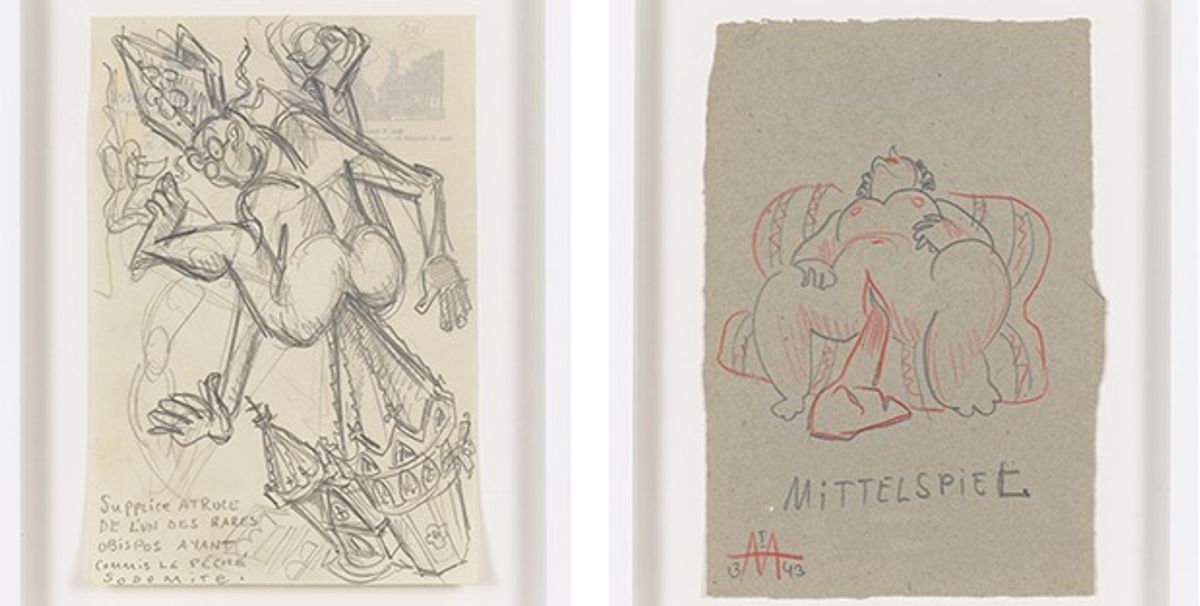Sergei Eisenstein was an auteur of film classics like October (1928) and Battleship Potemkin (1925) and a theoretician of cinema. He also designed sets for stage productions and drew those designs himself.
But his draftsmanship was not so limited. Alexander Gray gallery in New York is now showing his erotic pictures, ranging from scenes of murder taken from Shakespeare’s Macbeth, to biblical stories, to couplings of humans and plants. There is a bawdy wit in this work that goes beyond any humour found in his films. Out of 5,000 drawings by Eisenstein that survive, these are among the least known and the exhibition offers one surprise after another.
Admirers of Eisenstein’s films who might not have known the “secret drawings” may get a jolt from the explicit sex in these works that a private collector in France consigned to Alexander Gray gallery. They are just as likely to break down into laughter at scenes of sado-masochistic homosexuality, sex between humans and animals and between rabbits and alligators, and even circus acts in which penises perform.
Eisenstein was no Leonardo or Michelangelo, but he understood drama and how to entertain an audience. These works show that he knew comedy. The drawings that recall art deco and the continuous line of Alexander Calder have a whimsy and surprising warmth, given the subject matter, which suggest an acceptance of all sorts of sexual practices. (Eisenstein himself was a bisexual.)
Unlike much satire, this was not work conceived in anger. Even scenes of violence—like the buggering of a bishop with a church steeple—are cartoonish rather than sinister. That tone runs throughout the works on view.
One image that is not included in the show, but that is sure to be remembered when seen, is Cirque Etrange, drawn in Alma Ata (Kazakhstan) in 1942, in which a penis decorated with stars walks a tightrope strung between two nude boys with erections. A bourgeois family watches the scene from the circus floor. The elements are so wildly irreverent and so Modern that they could have been a model for Seth Rogin’s sexually charged satire film of last summer, Sausage Party.
He avoided direct references to politics in the drawings—a wise choice for a Soviet citizen under Stalin—and the works have been called acts of sublimation for a man confused about his sexuality. Yet they also point in an odd direction, toward Walt Disney, whom Eisenstein revered. These drawings may be his effort to transcend the confines of the human body, as Disney did with his animal characters.
Eisenstein’s characters are often shown experiencing a sexual pleasure that he associated with ekstasis, a physical and emotional joy that he cited in his writings. For that reason, some scholars resist calling the drawings erotic or pornographic, stressing that they give pleasure rather than serve sexual needs. Visitors to the show will not need to make that distinction to enjoy them.
Eisenstein (1898-1948) drew throughout his life, yet the sex drawings, as scholars call them, seem to have come to life during his stay in Mexico, beginning in 1930, where he worked on the unfinished film ¡Que viva México!, an epic about the history and culture of the country. Some drawings with Mexican fauna reflect where they were made.
Eisenstein was summoned back to Russia by Stalin in 1932 and the drawings were discovered and nearly confiscated by US Customs agents who searched his luggage when Eisenstein crossed from Mexico into the United States. His American patron, Upton Sinclair, was said to have been disgusted by the works.
In New York, Eisenstein gave some sex drawings to the dealer John Becker to sell, but took most of the sheets back to Russia.
Once in his homeland, where homosexuality was criminalized in 1934, Eisenstein married a close friend (at Stalin's orders, some historians believe), but the marriage was never consummated and the two lived separately.
Although the KGB, which monitored the lives of Soviet artists, was sure to have known of the drawings, the works were not objectionable enough to keep Eisenstein from being commissioned to make his film Ivan the Terrible. Once in Alma Ata, where it was shot, he made more and equally obscene pictures, including parodies of Ivan's sexual proclivities. Some of those pictures on view at the Alexander Gray gallery.
The State Hermitage Museum in St. Petersburg now holds a significant number of Eisenstein’s sex drawings, but has never exhibited them in Russia, where Orthodox Church figures routinely condemn homosexuality and anything that might be considered obscene. Another trove of the drawings is in the Russian State Archives of Literature and Art in Moscow.
David D’Arcy is a correspondent for The Art Newspaper
Sergei Eisenstein: Drawings 1931–1948, Alexander Gray Associates, New York, until 11 February


